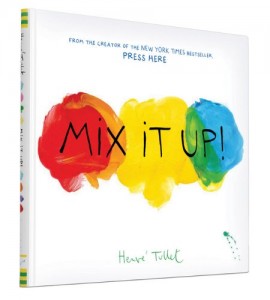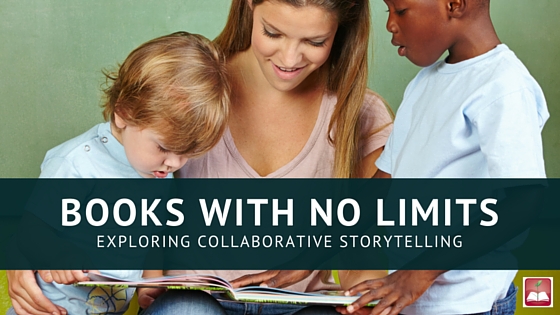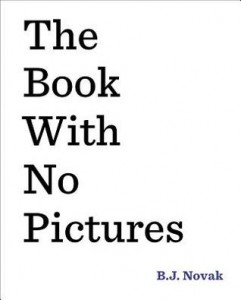Gail Cornwall | The Children’s Book Review
Most children’s books feature what education theorists call “frontal instruction”: the caregiver reading the book delivers information, and the child absorbs it with little real interaction or collaboration. To be sure, individual readers can make the experience more child-centered by engaging kids in a dialogue as they go. Plus there have long existed books that challenge this model at the fringes, like pop-up books or the little board books with textured pages (think Pat the Bunny).
In recent years, however, a group of children’s authors has revolutionized the process of storytelling. Mo Willems’ wildly popular Don’t Let the Pigeon Drive the Bus provides a perfect example. At the outset, a bus driver instructs the kids not to allow the pigeon to drive the bus. On almost every subsequent page, the pigeon asks to drive the bus in an increasingly creative and desperate way, and the kids have to say (or shout, in my little ones’ case), “No! No, pigeon! No way!”
Two new books—presented by JCC San Francisco’s “Arts and Ideas” family series—take this interactive bent even further, one by way of encouraging writing and the other artistic exploration.
In The Book with No Pictures, B.J. Novak (best known by parents as Ryan from The Office until the release of his wickedly smart and funny adult book One More Thing) teaches kids to think of words as instruments of excitement and power. The book sets the stage by having the reader explain, “Here is how books work: Everything the words say, the person reading the book has to say. No matter what.” The primary script continues, listing a series of silly statements such as, “My only friend in the whole wide world is a hippo named BOO BOO BUTT.”
The genius lies in the asides that follow each bout of ridiculousness in a smaller, less colorful type. For example, after saying, “I am a monkey who taught myself to read” in a read-aloud voice, the caregiver then says, “Hey! I’m not a monkey!” These asides, which Novak likens to a reaction shot of straight-man Jim on The Office, naturally push the adult to ham it up, feigning frustration that the kid has tricked her into saying something ludicrous and eventually even begging to be allowed to stop reading. In comedy parlance, it kills. Kids go absolutely bonkers, punch drunk on a combination of silliness and control.
 The latest from Hervé Tullet, known as “The Prince of Preschool” in France, similarly breaks the storybook mold, instructing children to physically manipulate the book in one way or another in order to teach color mixing. In Mix It Up, the follow-up to NY Times bestseller Press Here, a page has three circles of paint: one red, one yellow, and one blue. The caregiver reads, “With one finger take a little bit of the blue. And just touch the yellow. Rub it . . . gently . . . .” When you turn the page, voilà, a green circle appears.
The latest from Hervé Tullet, known as “The Prince of Preschool” in France, similarly breaks the storybook mold, instructing children to physically manipulate the book in one way or another in order to teach color mixing. In Mix It Up, the follow-up to NY Times bestseller Press Here, a page has three circles of paint: one red, one yellow, and one blue. The caregiver reads, “With one finger take a little bit of the blue. And just touch the yellow. Rub it . . . gently . . . .” When you turn the page, voilà, a green circle appears.
The pages that follow show complex color combinations and maneuvers (like tilting the book sideways) that allow kids to feel like they’re actually producing the page that follows through their responsive actions. My kids inevitably ask to paint after we finish reading the book, an urge Tullet clearly seeks to incite; he even orchestrated the creation of a massive mural after his reading, somehow creating more art than havoc after filling the JCCSF lobby with dozens of paint-wielding toddlers.
Again, enthusiastic storytelling can render a traditional picture book just as captivating as The Book with No Pictures and Mix It Up; but as Novak notes, there’s a huge value added for parents in not having to drum up the energy to improvise at the end of a long day.
If you enjoyed reading “The Books With No Limits: Exploring Collaborative Storytelling,” an article by Gail Cornwall, discover more articles and books by checking out our pages tagged with Reading Aloud, Interactive Books, and Picture Books.



2 Comments
Pingback: The Books With No Limits: B.J. Novak, Hervé Tullet, and Storytelling That’s Both Inspired and Inspirational | Parenting Write
Mix It Up (along with Press Here) is one of my daughter’s newest favorite books. I thought that with touch screens as widespread as they are (she uses them a lot in school), she might find it boring. But she loves it and finds it magical that something happens when she interacts with the book.
I find all Mo Willems books are great for getting kids to interact in the storytelling. If nothing else, they like to search for the Pigeon hidden somewhere in each of his books.